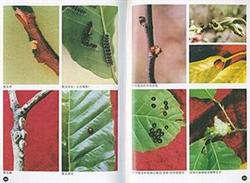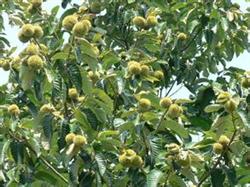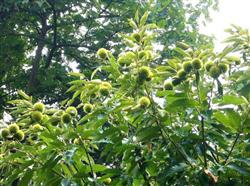Control methods of insect pests in Chinese chestnut

1. Chestnut gall wasp, also known as chestnut tumor peak, adult head and abdomen dark brown, antennae filiform, brown, chest dilated, pitch black, lay eggs in the bud from June to July, and the larvae grow in the bud and overwinter. In spring, buds sprouted and produced short branches, damaged branches or petioles and other inflated adult galls (tumors), which withered the branches and leaves, weakened the tree, and seriously affected the growth and fruit of the current year and the next year. Control methods: ① cut off delicate branches, disease and insect branches and burned them in winter to eliminate overwintering larvae. ② protects predators, jumping wasps. ③ adults spray 40% omethoate 1000 times before and after Eclosion (June-July), or brush the dry branches with 40% omethoate in early April (chestnut buds are red and inflated but not open). A branch about 10 cm thick can be scraped off the cork layer on a 30 cm semicircle and brushed with about 10 ml of medicine. two。 The adult of Monochamus alternatus is dark brown, the forechest dorsal plate has 2 white spots, and the larva forechest dorsal plate has "mountain" shaped brown spots. It mainly harms the branches, causes withered branches and affects the tree potential. Control methods: ① killed adults before spawning from May to July. From June to July, ② scraped off the eggs and newly hatched larvae of tree trunks. ③ used wire hooks to kill larvae that had been eaten into the tree trunk. ④ plugs the wormhole with 80% dichlorvos 100x solution or cotton ball with 50% phosphoamine (or 50% fenitrothasone) 40 times solution. 3. The adult of the red-winged moth looks like a bumblebee. The female adult has a yellow abdomen, a reddish purple waist, a transparent wing membrane, brown hairs on the legs, and a spinning Dong cocoon embellished with silk, insect dung and sawdust in vitro. The larvae overwintered under the cortex of the branches and began to move in April of the following year. During the peak period of adult Eclosion from late August to late September, the larvae laid eggs in the rough bark cracks or insect tracks of the trunk, especially in the trunk of 10-70 cm above ground. It mainly harms the phloem of the trunk and main branch, the tumor-like eminence of the injured site, the warping of the cortex, the scar does not heal for a long time, and the tree dies in serious cases. Control method: during the peak period of adult ①, the trunk sprayed 1000 times of dichlorvos to kill adults and newly hatched larvae. ② looked for insect feces to scrape off the larvae. ③ 80% dichlorvos, 1% kerosene and 30 parts of tree trunk. 4. Chestnut weevil adult is small, black or dark brown, 7-9 mm long and has a slender beak. The larvae are fusiform and milky white. The larvae feed on kernels, mature about 10 days after harvest, drill out chestnut and make cocoons for overwintering. Control method: the canopy of ① adult is sprayed with 1000 times solution of 90% trichlorfon or 80% dichlorvos. ② fumigated chestnut. Under airtight conditions, 2.5-3.5 grams of methyl bromide per cubic meter of chestnut was fumigated for 24-48 hours, or 30 ml of carbon disulfide was used for 20 hours to kill pests without affecting germination. ③ chestnut temperature, hot water to kill larvae. Soaking in 50-55 ℃ warm water for 15-30 minutes, or 90 ℃ hot water for 10-30 seconds, the insecticidal rate could reach more than 90%, and the germination ability was not affected. 5. Peach borer, also known as peach heart borer, fruit spot borer moth, etc., adults are bright yellow, with rows of black spots on the back and sides of the abdomen. The larvae overwintered in the involucre of the bark crack or trunk, and after Eclosion, the adults laid eggs in the involucre about August. After hatching, the larvae entered through the involucral bract stalk, often causing serious fruit drop. During the growth of chestnut, only a few old larvae eat into the chestnut fruit, but a large number of cavities after harvest can often make the chestnut fruit hollow, and the uneaten chestnut fruit loses its edible value by adhering to insect dung and filamentous matter. Control method: ① larvae were sprayed with 1000 times of dichlorvos during the incubation period. Within 5-6 days after harvest, ② involucre was shelled and chestnut was removed in time to reduce the damage. After ③ harvest, the involucre was fumigated with carbon disulfide, or the involucre was soaked in 100 times the liquid speed of 90% trichlorfon. 6. The chestnut red spider harms the leaves with adults and nymphs, making the damaged leaves pale and small, and finally yellowish brown scorched and early fallen leaves. It overwintered as eggs on the back of branches, hatched from late April to mid-May, and reached its peak from mid-May to early July. Control method: the crown of ① was sprayed with dicofol 800-1000 times, or 40% dimethoate 1000 times. ② smeared the trunk with medicine in the first and middle of May, scraped 10 cm band at the base of the trunk (only scraped off the rough skin, slightly exposed the tender skin), applied 40% dimethoate 1-10 times or 50% monocrotophos 1-20 times, applied once more after the solution was slightly dry, and then wrapped with plastic film. 7. Red foot green beetle red foot green beetle also known as copper green beetle, adults harm tender leaves and inflorescences, often eat leaves into a network. The larvae bite on the roots, weakening and even withering the trees. The larvae overwintered in the soil and emerged from late April to early May. The peak period of adults was from June to July. Control method: ① poisoned larvae. Spread 3% carbofuran 1-1.5kg per mu evenly and then rake the soil, or irrigate it with 1000 times of phoxim. During the peak period of adult ②, 90% trichlorfon 1500 times solution or 80% dichlorvos 1000 times solution was sprayed at night. ③ is killed by artificial shock in the morning or evening. ④ traps and kills with lights at night. 8. Plutella xylostella larvae are hidden in the bag, stand on the leaves or hang on the back of the leaves, eat the leaves, eat strongly, and often eat up the leaves of the whole tree. Control method: ① tree crown sprayed with 80-1500 times of trichlorfon solution. ② removed the pouch.
- Prev

Summer fertilization of Chinese Chestnut
In order to improve the yield and quality of Chinese chestnut, chestnut trees should be fertilized in summer. there are two main fertilization methods: soil fertilizer method: the soil fertilizer method is better in the chestnut orchard with thin soil and serious lack of fertilizer. In the chestnut crown drip line, dig a circular ditch for fertilization, 25 cm wide and 2 cm deep.
- Next

Supplement micro-fertilizer to Chinese chestnut after production
The main reason for the low yield and high empty bract rate of chestnut orchard is that it is not applied or sprayed with boron fertilizer in the process of management. When the content of available boron in soil is less than 0.5 parts per million, it will affect the normal fertilization process of Castanea mollissima, resulting in the early stagnation of embryonic development, thus forming the empty bud of Castanea mollissima. It can be grasped in production.
Related
- Moge, come on! The staff of the peasant association in the producing area of cantaloupe were frightened when the crowd gathered.
- Causes and Solutions of low Fruit setting rate of Apple
- Symptoms and control measures of passion fruit virus disease
- Fruit growing lesson: how do apple orchards keep high yields?
- Can you build orchards in the mountains? What are the pros and cons?
- How to manage the coloring period of Crisson grape?
- This paper introduces the processing technology of two kinds of fig products.
- How much is a month for retired teachers in rural areas by 2020?
- How can strawberry planting increase sugar content? We should pay attention to management in many aspects.
- What are the cultivation techniques on how to improve the yield of golden fruit?

